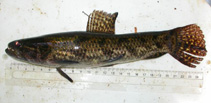Envoyez vos Photos et vidéos
Pictures | Images GoogleHoplias aimara
Picture by Brosse, S.
Pictures | Images GoogleHoplias aimara
Picture by Brosse, S.
Brazil country information
Common names:
Traira, Traíra gigante, Trairão
Occurrence: native
Salinity: freshwater
Abundance: | Ref:
Importance: | Ref:
Aquaculture: | Ref:
Regulations: | Ref:
Uses: live export: yes;
Comments: Known from the Rios Araguari and Amapá, state of Amapá (Ref. 57715).
National Checklist:
Country Information: https://www.cia.gov/library/publications/resources/the-world-factbook/geos/br.html
National Fisheries Authority:
Occurrences: Occurrences Point map
Main Ref: Mattox, G.M.T., M. Toledo-Piza and O.T. Oyakawa, 2006
National Database:
Occurrence: native
Salinity: freshwater
Abundance: | Ref:
Importance: | Ref:
Aquaculture: | Ref:
Regulations: | Ref:
Uses: live export: yes;
Comments: Known from the Rios Araguari and Amapá, state of Amapá (Ref. 57715).
National Checklist:
Country Information: https://www.cia.gov/library/publications/resources/the-world-factbook/geos/br.html
National Fisheries Authority:
Occurrences: Occurrences Point map
Main Ref: Mattox, G.M.T., M. Toledo-Piza and O.T. Oyakawa, 2006
National Database:
Common names from other countries
Classification / Names Noms communs | Synonymes | Catalog of Fishes(Genre, Espèce) | ITIS | CoL | WoRMS | Cloffa
> Characiformes (Characins) > Erythrinidae (Trahiras)
Etymology: Hoplias: Greek, hoplon = weapon (Ref. 45335).
More on author: Valenciennes.
Etymology: Hoplias: Greek, hoplon = weapon (Ref. 45335).
More on author: Valenciennes.
Issue
No recent work, see original description.
Environment: milieu / climate zone / depth range / distribution range Écologie
; eau douce benthopélagique; potamodrome (Ref. 51243). Tropical
Distribution Pays | Zones FAO | Écosystèmes | Occurrences | Point map | Introductions | Faunafri
South America: Tributaries of middle and lower Amazon basin, including Rios Trombretas, Jari, Tapajós, Xingu, Tocantins, and in the coastal rivers of Guyana, Suriname, Fr Guiana; Rios Araguari and Amapá, state of Amapá, Brazil; lower reaches of Río Orinoco, Venezuela.
Length at first maturity / Taille / Poids / Âge
Maturity: Lm 22.0, range 22 - 22 cm
Max length : 100.0 cm SL mâle / non sexé; (Ref. 12225); poids max. publié: 40.0 kg (Ref. 12225)
Max length : 100.0 cm SL mâle / non sexé; (Ref. 12225); poids max. publié: 40.0 kg (Ref. 12225)
Frequently occurs in counter current zones of principal rivers and creeks. Feeds mainly on fish but also on other animals that fall into the water like small terrestrial invertebrates. Is active at dusk and at night. Reproduction takes place at the onset of the rainy season from December to March. Depending on the size, the female can carry around 6,000 to 60,000 eggs (Ref. 12225). Known for the quality of its flesh (Ref. 27188).
Life cycle and mating behavior Maturité | Reproduction | Frai | Œufs | Fécondité | Larves
Référence principale
Upload your references | Références | Coordinateur : Oyakawa, Osvaldo T. | Collaborateurs
Planquette, P., P. Keith and P.-Y. Le Bail, 1996. Atlas des poissons d'eau douce de Guyane. Tome 1. Collection du Patrimoine Naturel Volume 22, MNHN, Paris & INRA, Paris. 429 p. (Ref. 12225)
Statut dans la liste rouge de l'IUCN (Ref. 130435: Version 2024-2)
Préoccupation mineure (LC) ; Date assessed: 07 August 2020
Menace pour l'homme
Harmless
Utilisations par l'homme
Pêcheries: commercial; Aquarium: Commercial
FAO(Publication : search) | FishSource |
Plus d'informations
Trophic ecology
Éléments du régime alimentaire
Composition du régime alimentaire
Consommation alimentaire
Food rations
Prédateurs
Éléments du régime alimentaire
Composition du régime alimentaire
Consommation alimentaire
Food rations
Prédateurs
Population dynamics
Paramètres de croissance
Max. ages / sizes
Length-weight rel.
Length-length rel.
Fréquences de longueurs
Mass conversion
Recrutement
Abondance
Paramètres de croissance
Max. ages / sizes
Length-weight rel.
Length-length rel.
Fréquences de longueurs
Mass conversion
Recrutement
Abondance
Anatomy
Surface branchiale
Brain
Otolith
Surface branchiale
Brain
Otolith
Physiology
Body composition
Nutrients
Consommation d'oxygène
Type de nage
Vitesse de nage
Visual pigments
Fish sound
Diseases & Parasites
Toxicity (LC50s)
Body composition
Nutrients
Consommation d'oxygène
Type de nage
Vitesse de nage
Visual pigments
Fish sound
Diseases & Parasites
Toxicity (LC50s)
Genetics
Génétique
Heterozygosity
Héritabilité
Génétique
Heterozygosity
Héritabilité
Human related
Aquaculture systems
Profils d'aquaculture
Souches
Ciguatera cases
Stamps, coins, misc.
Aquaculture systems
Profils d'aquaculture
Souches
Ciguatera cases
Stamps, coins, misc.
Outils
E-book | Guide de terrain | Générateur de fréquences de longueur | Outil de dynamique de population | Carte par point | Classification Tree
| Catch-MSY |
Articles particuliers
Télécharger en XML
Sources Internet
Aquatic Commons | BHL | Cloffa | Websites from users | FishWatcher | CISTI | Catalog of Fishes(Genre, Espèce) | DiscoverLife | ECOTOX | Faunafri | Fishtrace | GenBank(génôme, nucléotide) | GloBI | GOBASE | | Google Books | Google Scholar | Google | IGFA World Record | MitoFish | Otolith Atlas of Taiwan Fishes | PubMed | Reef Life Survey | Scirus | SeaLifeBase | Arbre de Vie | Wikipedia(aller à, chercher) | World Records Freshwater Fishing | Zoological Record
Estimates based on models
Phylogenetic diversity index (Ref. 82804): PD50 = 0.5001 [Uniqueness, from 0.5 = low to 2.0 = high].
Bayesian length-weight: a=0.00741 (0.00447 - 0.01229), b=3.13 (2.98 - 3.28), in cm Total Length, based on LWR estimates for this species & (Sub)family-body (Ref. 93245).
Niveau trophique (Ref. 69278): 3.7 ±0.55 se; based on food items.
Résilience (Ref. 120179): Milieu, temps minimum de doublement de population : 1,4 à 4,4 années (tm=1; Fec=6,000).
Fishing Vulnerability (Ref. 59153): High to very high vulnerability (73 of 100).




